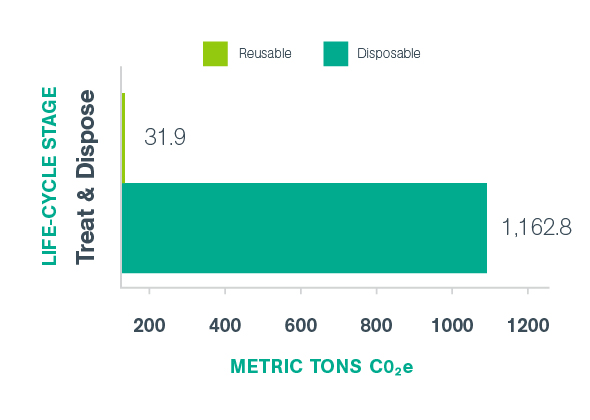The Proven Carbon Footprint Reduction of Switching to Reusables
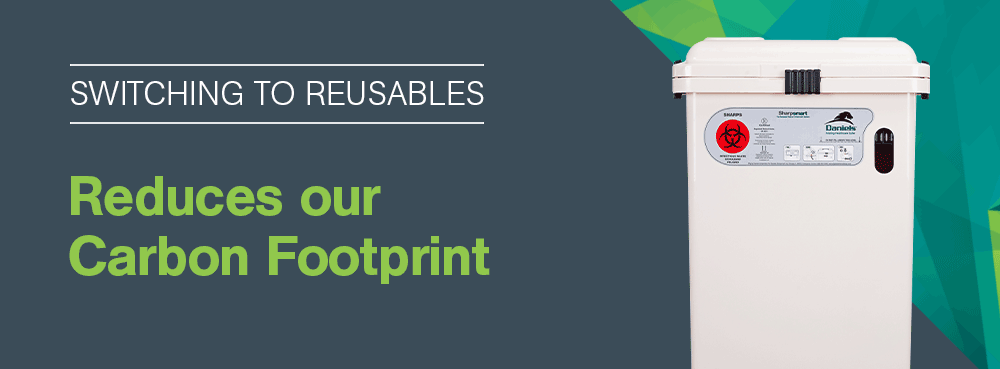
As key decision-makers in acute healthcare facilities, it’s important to consider the impact your hospital is having on the environment; not only for the benefit of public health and the planet, but also to meet the sustainability benchmarks that may have been set for your facility.
Increasingly, hospitals across the globe are setting ambitious sustainability targets, and the United Kingdom in particular has emerged as a leader in developing net zero requirements for facilities in the National Health Service (NHS). Sustainable waste management, anchored by reusable containers, is a key strategy that hospitals are deploying for achieving their targets. The example set in the UK is something that is worth studying and emulating here in the United States.
In this blog, we’ll look at the net zero goal of the NHS and the proven carbon footprint reduction of switching to reusables; we’ll also highlight the financial benefits of making the change and why it’s worth considering now.
TOPICS WE WILL COVER:
1 / The net zero goal of the NHS
2 / The “Impact on life-cycle carbon footprint” study
3 / The proven carbon footprint reduction of switching to reusables
4 / Financial benefits of reusable sharps containers
5 / Is switching to reusables worth the hassle?
6 / Are you considering switching to reusables?
The Net Zero Goal of the NHS
Before establishing the sustainability benefits of switching to reusables, it’s worth taking a brief look at the carbon reduction goals of the NHS. The NHS is striving to become the world’s first net zero national health service, committed to becoming net zero by 2040.
Switching to reusable sharps containers is an effective way that the NHS can make a significant impact on carbon reduction with minimal disruption or need for staff behavioral change.
Let’s look at why that’s the case…
The “Impact on Life-Cycle Carbon Footprint” Study
This study, conducted by Grimmond TR, Bright A, Cadman J, et al, and published in the British Medical Journal Open; investigated the NHS’s commitment to being the world’s first net zero healthcare service through “…reducing waste, unnecessary plastics, and single-use items”.
The objective was to compare the global warming potential of hospitals converting from single-use disposable sharps containers to reusables. The study was conducted over a 12-month period across 40 acute care trusts; representing three-quarters of NHS trusts using reusable sharps containers at the time.
The study took into account and considered the impact on greenhouse gas emissions, plastic manufactured, and cardboard used across the 40 acute NHS trust hospitals that switched to reusables.
The Proven Carbon Footprint Reduction of Switching to Reusables
It’s crucial to examine all life-cycle stages to fully understand the sustainability benefits of reusable sharps containers; from the production of raw materials and manufacturing to transportation, cleaning, treatment and disposal. By examining the stages, the evidence shows that reusable containers have a much smaller environmental impact when compared to single-use containers. Detailed below are the life-cycle carbon reductions that were made by the 40 acute care NHS trusts who switched from single-use containers to reusables.
Manufacture
Including all raw materials involved in the manufacture of both container types: Reusables removed 2,062.7 tons of CO2e.
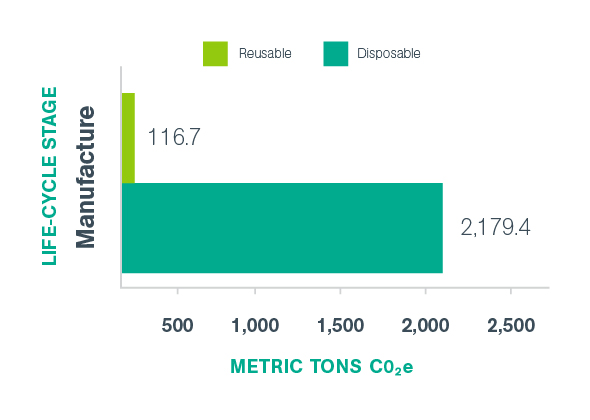
Transport
The transport throughout the entire life-cycle of both container types; including their delivery to the trust from their point of manufacture, and their transportation from the trust to the relevant treatment and disposal facility. Reusables reduced 112.2 tons of CO2e.
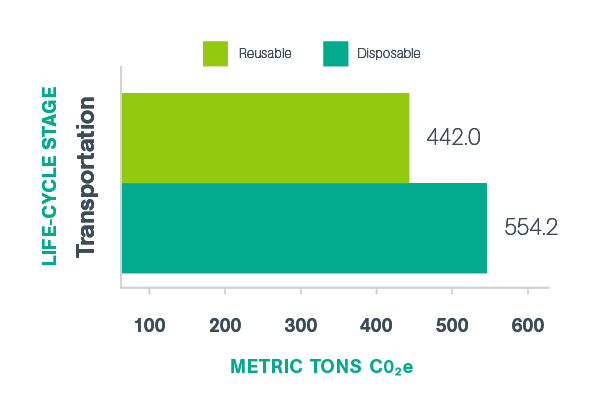
Wash
To ensure their maximum years of use, reusable containers are required to be thoroughly cleaned and disinfected. Even so, their contribution to global warming potential is low when done using our sustainable Washsmart technology.
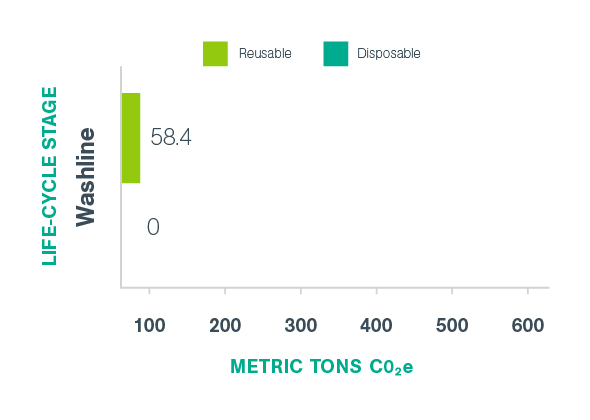
Treatment and disposal
When sharps containers are full they’re transported to an offsite treatment facility; single-use containers are then incinerated and the residual ash is landfilled. Once reusables are robotically decanted, processed, cleaned and quality checked, they’re returned to the service pool for reuse. At end-of-life, their parts are reused or recycled. In the treatment and disposal life-cycle stage:
Reusables reduced 1,130.9 tons of CO2e.
Takeaway
The biggest takeaway from the “Impact on Life-Cycle Carbon Footprint” study is that converting to reusable sharps containers is proven to be a sustainable purchasing decision that permanently reduces global warming potential. The 40 trusts that switched to reusable sharps containers reduced the carbon footprint of their sharps waste streams by a combined 3267.4 tons of CO2e—a reduction of 83.9%. This huge reduction in their carbon footprint also eliminated the incineration of 900.8 tons of plastic and the disposal of 132.5 tons of cardboard. The combined weight of plastic and cardboard saved from disposal is 1,033.3 tons—equivalent to the maximum take-off weight of 4.1 Boeing 787 Dreamliners!
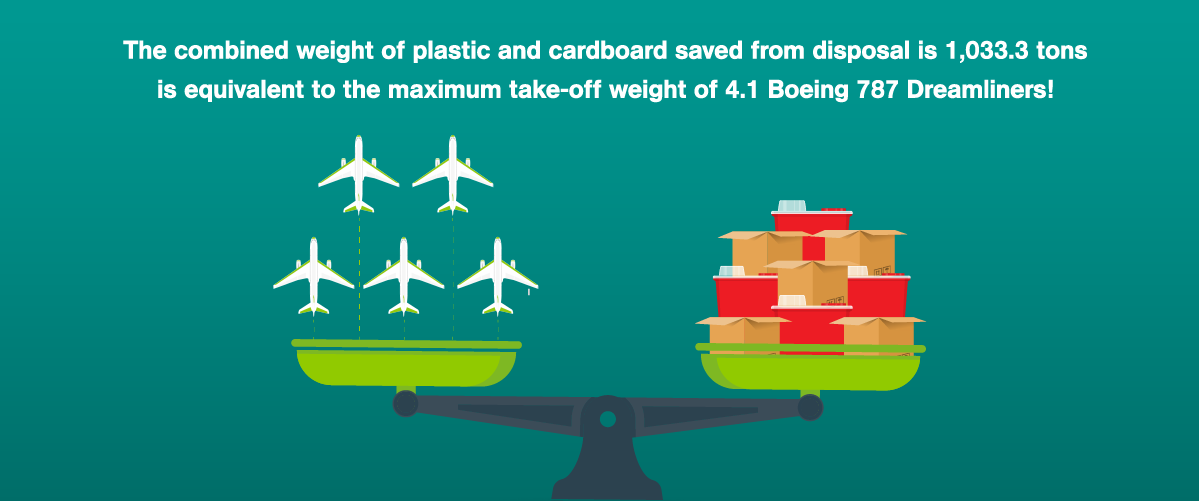
Financial Benefits Of Reusable Sharps Containers
In addition to the environmental benefits of reusable sharps containers, they also offer cost-efficiencies; while the initial investment may be slightly higher, the long-term savings can be significant.
Some of the cost-savings include:
- Reusables save your staff time – The “Impact on Life-Cycle Carbon Footprint” study highlighted that, annually, for every 100 beds you could save around 153 hours in exchanging full sharps containers.
- Reusables can be used multiple times – Reducing the need for continuous purchasing, they’re simply replaced with clean, empty containers once full.
- Reusables are more durable – Increased quality means they’re less likely to break or malfunction, reducing costly injuries or the need for replacements.
- Reusables are a safer option – Only when they’re ISO-compliant and engineered for safety such as Sharpsmart containers; which are clinically proven to reduce needlestick injuries by up to 87% and the costs associated with such injuries.
Is Switching to Reusables Worth It?
Change can feel like an overwhelming concept but to achieve net zero, it’s a necessity. Single-use containers while convenient, contribute significantly to greenhouse gas emissions and increased global warming potential. The production of single-use containers requires a lot of resources and energy, reusables on the other hand, have a much smaller environmental impact. When faced with the change of introducing reusable sharps containers, it’s good to remember that unlike many other carbon reduction strategies they’re not dependent on changing staff behaviour.
Adopting reusable sharps containers is an example of a sustainable purchasing decision that can assist hospitals in meeting their greenhouse gas reduction targets and can reduce global warming potential permanently with minimal staff behavioral change.
When you take into account the cost-saving and environmental benefits, along with the increased safety, quality and durability of reusables, it makes the switch to reusables a no-brainer. Your hospital can play a leading role in promoting sustainability by switching to reusables.
Are You Considering Switching to Reusables?
If you’re looking for a sustainable purchasing decision that can drastically reduce the carbon footprint of your hospital, switching to reusable sharps containers is a great choice. Daniels Health provides a safer, more efficient system that offers point-of-care solutions and optimized placement; ensuring you always have the right container types in the right places. Our expert consultants can offer you guidance and advice based on the specific needs of your hospital.
Get in touch if you’d like to learn more about switching to reusables and working towards a net zero future with minimal disruption and staff behavioral change.
Let's Talk!
Your time is valuable, and we don’t want to play hard to get. You can either phone us directly on the details listed on our contact page, or feel free to fill out this short form and one of our team members will get back to you as quickly as possible.
